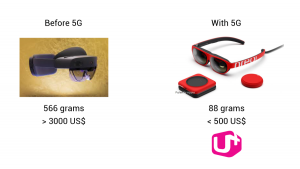This article is part of a four-part series on the power of API-powered platforms to transform the telecommunications industry. Part 1 discussed the game-changing nature of platforms using the automotive industry as an example, and Part 2 now shows how this same transformation came to the Telco industry (and the role of 5G in accelerating the transformation).
The patterns we’ve seen in the automotive or media industries are also happening in the telecommunications field. New companies find they can enter the telco space:
An interesting project regarding infrastructure is Facebook’s Telecom Infra Project, but we also have newer companies like WhatsApp and Zoom that are monetizing calls — which used to be a telco cash cow — or AWS, Netflix, and Google that are also offering content, a newer business model for telcos.
But I think there’s an opportunity to look at this as a complement instead of competition. Look at Vonage, for example.
Find opportunities for complementary offerings
Vonage partnered with WhatsApp to extend access to VIRA – the COVID-19 vaccine information chatbot – to WhatsApp users around the world. It’s a very useful use case and that’s the power of APIs: they allow you to quickly facilitate solutions in emergencies.
A significant number of mobile network operators are already leveraging Telecom APIs to support Robocall Detection and Unwanted Call Management. Some of these processes and procedures will become a bridge toward the mediation of loT network authentication and authorization.
Twilio, a US cloud communication provider created a COVID-tracking API to share with the community. Twilio is very well-known for its SMS platform. It’s very easy for a developer to send an SMS through Twilio thanks to APIs.
What’s interesting is to see these services from new entrants go beyond what telcos ever imagined. In this case with unwanted call handling: they can detect robocalls, so if a robot calls you, they can cut it off with the help of an API — allowing you to create a better experience for your users.
In June 2020, Twilio announced Messaging Insights, providing real-time analytics within the Twilio Console. It’s essentially a call management platform that allows a company to visualize all their traffic via APIs: customers can monitor message delivery and engagement, troubleshoot issues, and optimize effectiveness across channels for no additional cost – no coding required.
5G puts telcos at the center of next-gen services
I like to define 5G as the ability to transfer intelligence — which used to be locally stored — into the cloud. Where an API is an interface, 5G is just a translation of intelligence from a device to the Cloud.
Both in B2C and in B2B, operators have an incredible opportunity to create trusted digital ecosystems addressing the specific needs of sectors like automotive, manufacturing, eHealth, media, smart cities, and energy.
Let’s take the example of a virtual reality headset: it used to cost $3,000 for a heavy device that weighs more than a pound (566g). If you have to use a VR headset for work, that’s heavy, uncomfortable, and impractical, you’re less likely to use it.
But if you don’t have to store and analyze data locally, you can still combine rich intelligence with something much lighter — and now the headset is less expensive as well because the intelligence is hosted and shared in the cloud. That’s a fundamental change.
That’s exactly what one South Korean operator called LG U+ did: they are making it possible to create new work experiences for people who can have an augmented reality experience that we only dreamed of in the past.

Note that the interface between the device and the Cloud is enabled by APIs: enabling 5G with APIs creates a whole world of new possibilities in many industries.
The added value of the operators will necessarily increase beyond connectivity, due to the need to provide edge computing and storage infrastructures in different points of concentration, to host the algorithms supporting various use cases.
Stay tuned for Part 3, where I will discuss efforts to standardize APIs for telcos and share which APIs are especially advantageous for the industry. Then, in Part 4, I’ll share a real-world example of how a platform helped one Telco create new business models, drive more revenue, and improve the customer experience.
Learn how leading companies are co-creating value with partners and delivering engaging experiences for customers.


